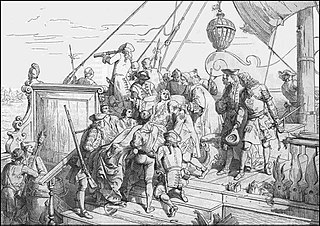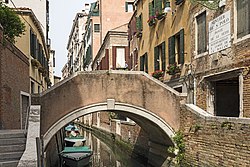
Venice is a city in northeastern Italy and the capital of the Veneto region. It is built on a group of 118 small islands that are separated by canals and linked by over 400 bridges. The islands are in the shallow Venetian Lagoon, an enclosed bay lying between the mouths of the Po and the Piave rivers. In 2020, around 258,685 people resided in greater Venice or the Comune di Venezia, of whom around 55,000 live in the historical island city of Venice and the rest on the mainland (terraferma). Together with the cities of Padua and Treviso, Venice is included in the Padua-Treviso-Venice Metropolitan Area (PATREVE), which is considered a statistical metropolitan area, with a total population of 2.6 million.

Cannaregio is the northernmost of the six historic sestieri (districts) of Venice. It is the second largest sestiere by land area and the largest by population, with 13,169 people as of 2007.

Bassano del Grappa is a city and comune, in the Vicenza province, in the region of Veneto, in northern Italy. It bounds the communes of Cassola, Marostica, Solagna, Pove del Grappa, Romano d'Ezzelino, Campolongo sul Brenta, Conco, Rosà, Cartigliano and Nove. Some neighbourhoods of these communes have become in practice a part of the urban area of Bassano, so that the population of the whole conurbation totals around 70,000 people.

Mazzorbo is one of various islands in the northern part of the Lagoon of Venice. Like the other islands in this part of the lagoon, it was the site one of the earliest settlements in the lagoon which predated the development of Venice. However, these islands then declined and were eventually abandoned. In the 1980s the architect Giancarlo De Carlo built a brightly coloured residential neighbourhood to help to repopulate Mazzorbo. In 2019 its population was 256. It is linked to Burano by a wooden bridge. It was once an important trading centre but is now known for its vineyards and orchards. Its main attraction is the fourteenth century church of Santa Caterina.

The Ponte delle Guglie is one of two bridges in Venice, Italy, to span the Cannaregio Canal. It lies near the western end of the canal, by the Venezia Santa Lucia railway station.

Comacchio is a town and comune of Emilia Romagna, Italy, in the province of Ferrara, 48 kilometres (30 mi) from the provincial capital Ferrara. It was founded about two thousand years ago; across its history it was first governed by the Exarchate of Ravenna, then by the Duchy of Ferrara, and eventually returned to be part of the territories of the Papal States. For its landscape and its history, it is considered one of the major centres of the Po delta.

Valstagna is a town and comune in the province of Vicenza, Veneto, northern Italy, It is connected to the frazione Carpanè of San Nazario by a bridge and it is accessible by SS47 Provincial Road.The biggest towns nearby Valstagna are Bassano del Grappa, Marostica, Asiago, Trento and Venice.

Mestre is a borough of the comune (municipality) of Venice, on the mainland opposite the historical island city in the region of Veneto, Italy.

Venezia Santa Lucia is the central station of Venice in the north-east of Italy. It is a terminus and located at the northern edge of Venice's historic city . The station is one of Venice's two most important railway stations; the other one is Venezia Mestre, a mainline junction station on Venice's mainland district of Mestre. Both Santa-Lucia and Mestre stations are managed by Grandi Stazioni and they are connected to each other by Ponte della Libertà.

The Lagunari Regiment "Serenissima" is the an active unit of Italian Army's infantry arm's amphibious Lagunari speciality. The name of the specialty comes from the Italian word for lagoon, while the regiment's name "Serenissima" commemorates the Most Serene Republic of Venice. The regiment is based in Venice and assigned to the Cavalry Brigade "Pozzuolo del Friuli". The "Pozzuolo del Friuli" brigade forms, together with the Italian Navy's Third Naval Division and San Marco Marine Brigade, the Italian Armed Forces' Sea Projection Force.

The Venice Marathon is a marathon road race that has been held each year in Venice since 1986, usually in October. The course starts in Stra and passes through Mestre, Parco San Giuliano, and Ponte della Libertà before ending at Riva dei Sette Martiri in Venice. The marathon is categorized as a Bronze Label Road Race by World Athletics.

San Vidal is a former church, and now an event and concert hall located at one end of the Campo Santo Stefano in the Sestiere of San Marco, where it leads into the campiello San Vidal, and from there to the Ponte dell'Accademia that spans the Grand Canal and connects to the Sestiere of Dorsoduro, Venice, Italy.

The church of Santa Maria delle Penitenti, is part of a large complex: Pio Loco delle Penitenti, located on the canal Cannaregio, near its exit to the lagoon facing Mestre, in the Northwest edge of Venice, Italy. It gained its name as a charitable institution providing an alternative life to former prostitutes, akin to a Magdalene asylum.

The Riva degli Schiavoni is a monumental waterfront in Venice. It is located in the sestiere of Castello and extends along the San Marco basin in the stretch from the Ponte della Paglia bridge, close to the Doge's Palace to the rio di Ca' di Dio.

The Fontana Delle Tette is an old fountain in Treviso, Italy. Under the rule of the Venetian Republic it poured white and red wine during special celebrations. The name translates into English as "The Fountain of Tits". It features a topless woman squeezing her breasts and water coming out of her nipples.

The Magistrato alla Sanità was the office of the Republic of Venice definitively instituted in 1490 to manage public health in the city of Venice and its territories, with specific attention on preventing the spread of epidemics within the maritime republic. The magistracy was among the first health authorities in Europe to institute public inoculation projects to prevent the spread of infectious diseases.

Supper in the House of Simon the Pharisee is a 1544 oil on canvas painting by Moretto da Brescia, now in the Chiesa della Pietà in Venice, Italy.

Lodovico Flangini was a Venetian noble who served as Capitano Straordinario delle Navi during the Seventh Ottoman–Venetian War.



















